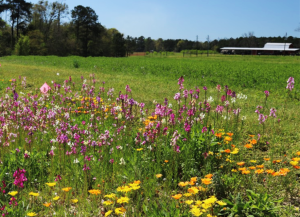
Native Wildflowers growing in field margins.
Whether you have wide open spaces, a small side yard, or patio planters, wildflowers are an excellent choice! By establishing native perennials and grasses, property owners may not only enjoy the beauty of a succession of flowers and varied plant forms, but also experience a renewed connection with nature.
When done properly, wildflower meadows enhance the biodiversity of a landscape and established plantings require minimal maintenance. Some of the ecosystem services meadows provide include stormwater infiltration, nutrient recycling, soil stabilization, and provisioning of food and shelter for biodiverse communities of flora and fauna.
If you’ve ever called the Extension office inquiring about what needs to be done to start a vegetable garden or backyard orchard, you probably recall me saying, “well, the first thing you’ll need to do is a soil test.” Of course, this is standard county agent advice, as soil testing can provide you with useful information for crop production, such as pH and nutrient content.
For those who aren’t apt to turn in a soil sample for analysis, you’ll be happy to hear that wildflowers aren’t too picky and generally prefer low-fertility sites! So, unless you have reason to believe your soil is unsuitable for plant life, you’ll probably be fine foregoing the soil sample. Site selection is really what comes into play for most wildflower species, so spend some time determining where in your landscape the soil tends to be wet or dry, and if the site gets full sun, filtered sun or shade.
Site selection is a critical step because not all wildflower species share the same growing requirements. A site with full sun and good drainage is ideal for many species, but partial shade and/or wet areas can be tolerated by many others. Before making any purchases, I recommend you consider your site and soil conditions carefully. Knowing that information up front will help you select an appropriate mix for your site.
Another thing to consider is the overall style/appearance you’re looking to achieve in your landscape. Wildflower meadows and pollinator gardens tend to be informal by nature, and can be a bit “wild and untidy” looking at certain times of the year. Knowing this, you may wish to locate it where it will be viewed from a further distance. If you’re looking for a neater, more designed meadow look but would still like to use wildflower plants, I recommend installing some small transplants (instead of broadcasting seed), and plant in intentional groupings for a more put together look.
Lastly, establishing a wildflower meadow from seed requires some dedication and an investment in time, but when done right from the start the end result is very rewarding. The first year is devoted to site preparation – this tends to be the least fun but also one of the most important parts. How and when to get started largely depends on the existing site characteristics and conditions, and what materials and methods you use.